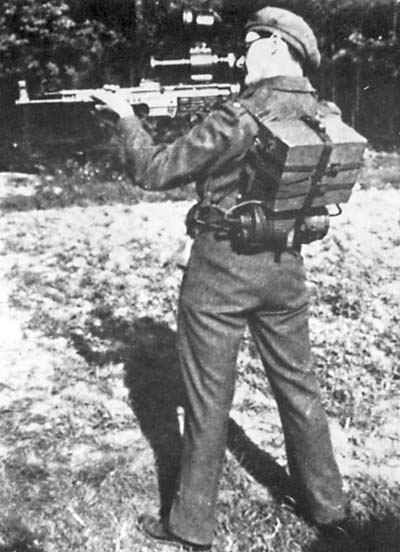Zielgerät 1229 on:
[Wikipedia]
[Google]
[Amazon]
 The ''ZG 1229 Vampir'' 1229 (ZG 1229), also known by its code name ''Vampir'', was an active infrared device developed for the ''
The ''ZG 1229 Vampir'' 1229 (ZG 1229), also known by its code name ''Vampir'', was an active infrared device developed for the ''
 The ''ZG 1229 Vampir'' 1229 (ZG 1229), also known by its code name ''Vampir'', was an active infrared device developed for the ''
The ''ZG 1229 Vampir'' 1229 (ZG 1229), also known by its code name ''Vampir'', was an active infrared device developed for the ''Wehrmacht
The ''Wehrmacht'' (, ) were the unified armed forces of Nazi Germany from 1935 to 1945. It consisted of the German Army (1935–1945), ''Heer'' (army), the ''Kriegsmarine'' (navy) and the ''Luftwaffe'' (air force). The designation "''Wehrmac ...
'' for the Sturmgewehr 44 assault rifle during World War II, intended primarily for night use. The ZG 1229 was designed by Allgemeine Elektrizitäts-Gesellschaft (AEG) and Forschungsanstalt der Deutschen Reichspost (RPF). It was produced by Ernst Leitz GmbH and approximately 310 units were built. A grenadier
A grenadier ( , ; derived from the word ''grenade'') was historically an assault-specialist soldier who threw hand grenades in siege operation battles. The distinct combat function of the grenadier was established in the mid-17th century, when ...
carrying it was known as a ''Nachtjäger'' (night-hunter).
Design
The ZG 1229 Vampir weighed and was fitted with lugs on theStG 44
The StG 44 (abbreviation of Sturmgewehr 44, "assault rifle 44") is a German assault rifle developed during World War II by Hugo Schmeisser. It is also known by its early designations as the MP 43 and MP 44 (''Maschinenpistole 43'' and ''44''). ...
at C.G. Haenel in Suhl, the weapons production facility. As well as the sight and infrared spotlight, there was a wooden-cased battery for the light weighing , and a second battery fitted inside a gas mask container to power the image converter. This was all strapped to a ''Tragegestell 39'' (pack frame 1939). The searchlight consisted of a conventional tungsten light source shining through a filter permitting only infrared light. The sensor operated in the near-infrared
Infrared (IR; sometimes called infrared light) is electromagnetic radiation (EMR) with wavelengths longer than that of visible light but shorter than microwaves. The infrared spectral band begins with the waves that are just longer than those of ...
(light) spectrum rather than in the thermal infrared
A thermal column (or thermal) is a rising mass of buoyant air, a convective current in the atmosphere, that transfers heat energy vertically. Thermals are created by the uneven heating of Earth's surface from solar radiation, and are an example ...
(heat) spectrum and was, therefore, not sensitive to body heat.
The image given was described as being of great brilliance and good contrast. Standing men could be discerned up to , especially when moving. However, reports indicate that ZG 1229 units were extremely delicate and considered too cumbersome for attack situations.
Use
Successful tests of the infrared sighting device for hand fire arms were made by the Panzergrenadiere during February and March of 1945. (According to other reports — the army trials never took place.) Deployment of StG 44s with ZG 1229 sights began only in the last months of the war, and most researchers agree that there is no reliable information considering combat use of the sights of this type. Nevertheless, Waldemar Trojca quotes Eastern Front veterans who claimed to have encountered German snipers using night sights onsmall arms
A firearm is any type of gun that uses an explosive charge and is designed to be readily carried and operated by an individual. The term is legally defined further in different countries (see legal definitions).
The first firearms originate ...
:
However, here he contradicts his own statement that the ZG 1229 was first used in combat in February 1945. In addition, the short target detection range would have made the use of this sight by snipers and machine gunners extremely difficult, if not impossible.
Similar infrared gear ( FG 1250) was fitted to the machine guns of Pz.Kpfw. V ''Panther'' tanks and Sd.Kfz. 251 ''Falke'' armored personnel carriers.
References
Bibliography
* * * *External links
* * {{DEFAULTSORT:Zielgerat 1229 World War II German electronics World War II military equipment of Germany Firearm sights Infrared imaging Night vision devices